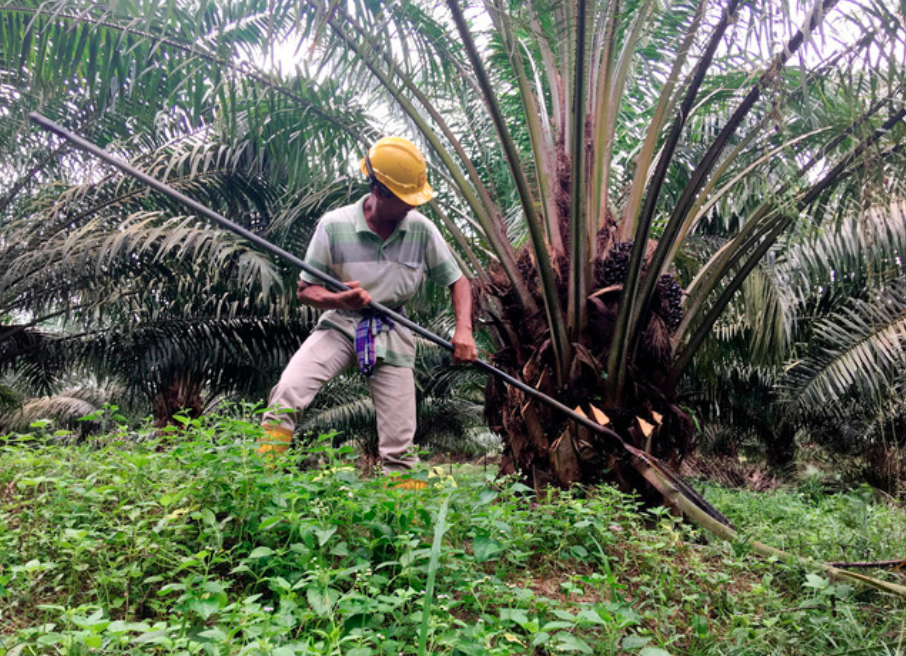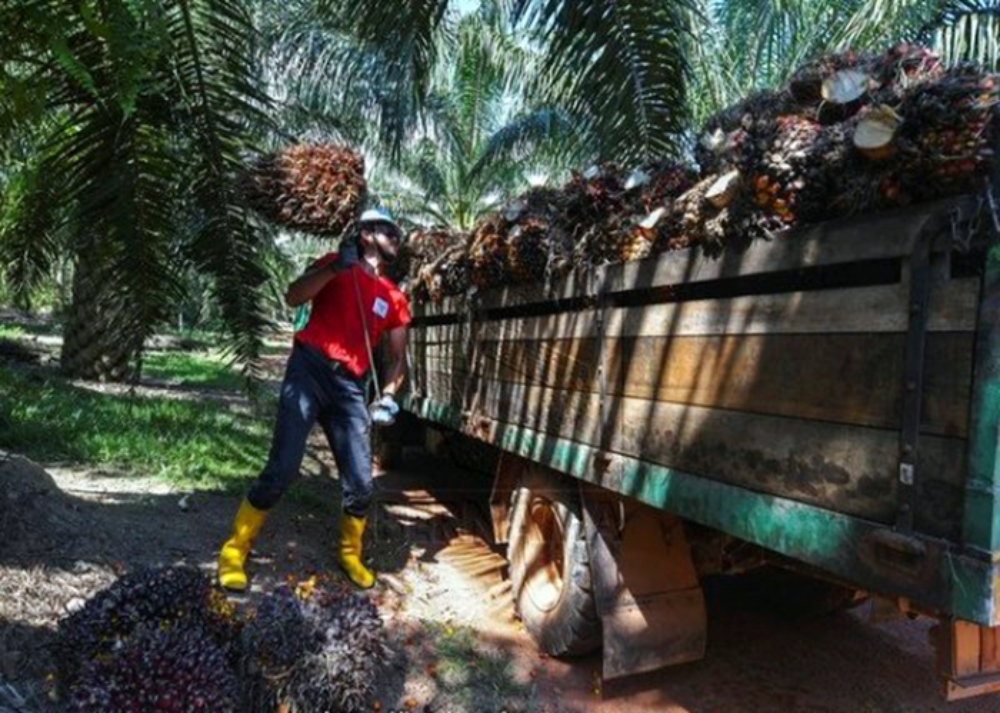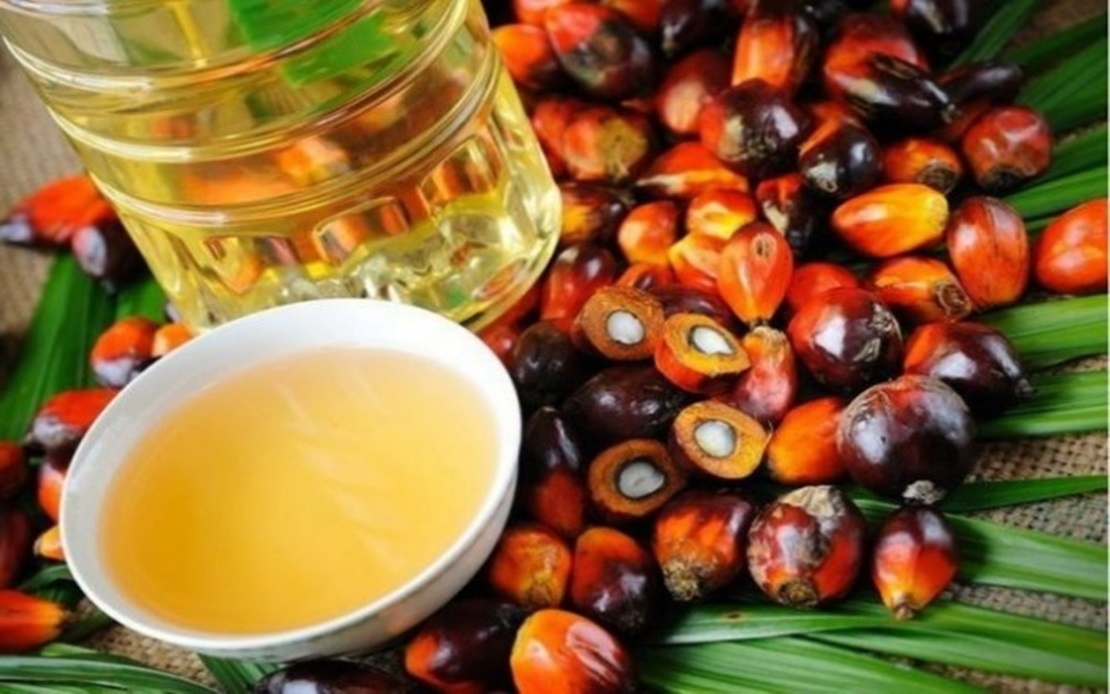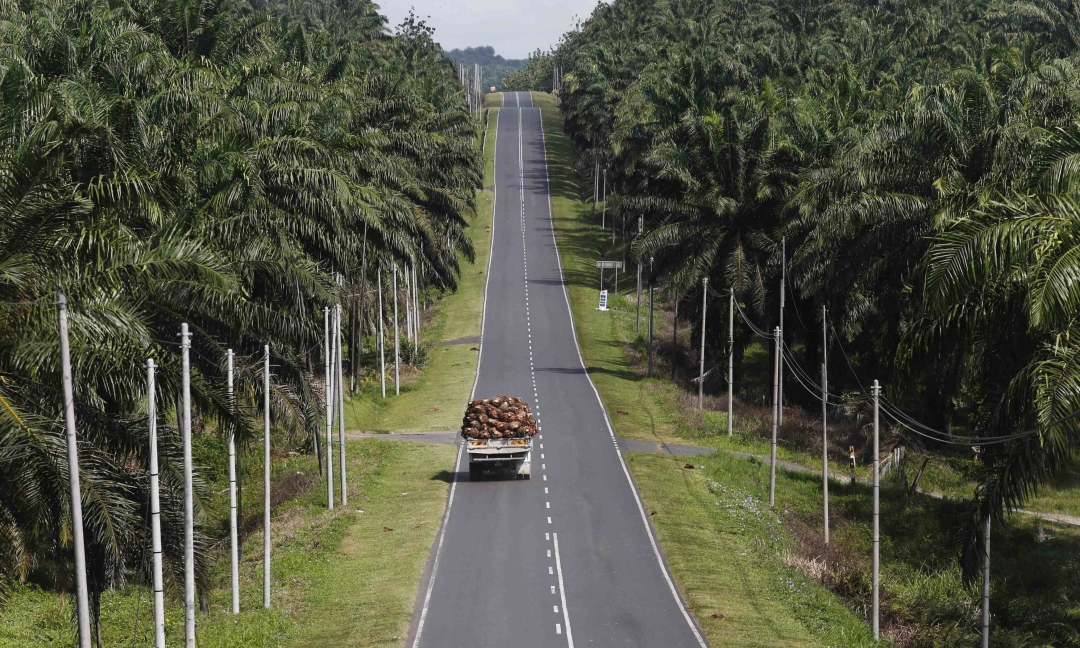15 associations want govt to immediately review windfall profit levy on palm oil
Thursday, 9 November 2023

he associations said they jointly seek a fair and balanced approach on the WPL that considers the industry’s present sectorial challenges and the pivotal need for long-term competitiveness and sustainability. — Bernama photo
KUCHING (Nov 8): A total of 15 associations affiliated with the palm oil supply chain have appealed to the federal government to immediately review and reconsider its windfall profit levy (WPL) on the commodity post the Budget 2024 announcement.
In a joint statement, the associations said they jointly seek a fair and balanced approach on the WPL that considers the industry’s present sectorial challenges and the pivotal need for long-term competitiveness and sustainability.
The associations are:
- Malaysian Palm Oil Association (MPOA)
- Malaysian Estate Owners’ Association (MEOA)
- National Association of Smallholders (NASH)
- Sarawak Oil Palm Plantation Owners Association (SOPPOA)
- Sarawak Dayak Oil Palm Planters Association (DOPPA)
- East Malaysian Planters Association (EMPA)
- Sabah Oil Palm Millers Association (SOPM)
- Sabah Employers Consultative Association (SECA)
- Palm Oil Millers Association (POMA),
- Palm Oil Refiners Association of Malaysia (PORAM)
- Malaysian Oleochemical Manufacturers (MOMG)
- Malayan Edible Oil Manufacturers’ Association (MEOMA)
- Malaysian Biodiesel Association (MBA)
- Malayan Agricultural Producers Association (MAPA)
- Incorporated Society of Planters (ISP)
The associations said the Malaysian palm oil industry, a cornerstone of the country’s economy, is currently at a critical juncture.
Despite being commodity centric, the sector has displayed remarkable resilience throughout the challenging Covid-19 period and thereafter.
While it faces numerous hurdles, including continued labour shortages and crop losses, the industry continues to contribute significantly to our nation’s economic growth, employment, and tax revenue.
The WPL, levied exclusively on all oil palm planters and no other business sectors in Malaysia, will cause undesirable ripple effects going forward throughout the oil palm supply chain and impact its overall sectorial long-term competitiveness and sustainability.
Over the past five years, the oil palm planters have been levied a substantial RM5.2 billion to the government’s coffers, with last year alone yielding over RM3 billion through the WPL.
“Our collective voice echoes the sentiments of the industry and underscores the need for meaningful and fair changes,” said the associations.
Commodity palm oil finds itself in a distinctive different position in the marketplace – it’s a price taker rather than a price maker.
Although the current year holds promise with relatively favourable crude palm oil (CPO) prices, the palm oil industry remains under the heavy weight of labour shortages leading to palpable losses in the fields and the continued national low yields that have led to today’s uppermost cost of production.
“It is discouraging to realise that there is abundant revenue to be made from the crop on the oil palm trees, but significant unharvested crop goes to waste and ends up rotting away without realising its commercial value,” the joint statement said.
“It’s worth noting that the WPL levied in Malaysia is exclusive levied on the oil palm industry in Malaysia. The term ‘windfall’ implies excessive profits. WPL on oil palm sector does not only impact the competitive edge of the industry’s upstream sector but will also affect through the entire supply chain, affecting stakeholders in the supply chain and will deteriorate in the future with lack of reinvestments against ageing oil palm trees and southward trending productivity.”
The associations said it stands to reason that the WPL threshold for triggering this levy should be reviewed to be set higher, especially considering today’s realities and to address the wrong notion that the planters have unceasingly been making windfall profits since its inception in 1999.

An oil palm plantation worker loads fresh fruit bunches into a truck. — Bernama photo
Media reports on Oct 26, 2023 have shed light on the Ministry of Finance’s (MoF) stance on the WPL for the palm oil industry.
The current WPL is charged based on the following formula with payment to be made within 28 days of the following month.
In Peninsular Malaysia, it is three per cent times monthly fresh fruit bunches (FFB) production times MPOB Malaysia’s monthly average CPO price of more than RM3,000 per tonne.
In Sabah and Sarawak, it is three per cent times monthly FFB production times MPOB Malaysia monthly average CPO price of more than RM3,500 per tonne.
Notwithstanding the WPL price threshold is based on CPO prices, the WPL is ultimately levied on all oil palm growers (excluding the smallholders) on their FFB production.
The MoF has expressed its intent to retain the WPL but remains open to revising its methodology including levy rates and profit threshold levels.
The associations welcome the latter statement, notwithstanding this is not new and has been reiterated numerous times.
“We implore on the government to pursue to completion a long-overdue taxation review initiated some years ago,” the associations said.
Despite initial anticipation, Budget 2024 did not present any awaited favourable outcomes regarding the WPL and other industry wants, they said.
Notably, Deputy Prime Minister and Minister of Plantation and Commodities Dato Sri Fadillah Yusof had earlier conveyed that his ministry submitted a proposal to the MoF to reduce the WPL in Budget 2024.
The submission included a proposal to lower and revert the WPL rate for Sabah and Sarawak from 3 per cent to 1.5 per cent respectively following engagement with MPOA.
“They (the industry) are not objecting to the WPL, but if it is imposed, they want to look at how the levy can benefit the industry, including in terms of incentives and programmes such as oil palm replanting,” Fadillah said.
The industry was also expectant then that portions of the WPL could be allocated and channelled to the levy-paying planters in Budget 2024 for replanting reinvestment allowance.
The MoF has highlighted that the WPL on the palm oil industry has been in place since 1999 with periodic revisions to the levy rate and price threshold value.
Notably, the adjustment to the levy rate in January 2022, equalising it between Peninsular Malaysia and Sabah and Sarawak, but may have not taken cognisance of the Sabah and Sarawak State Sales Taxes (SST) in the overall taxation equation.
This revision has led to a scenario where Sabah and Sarawak planters end up paying higher WPL than before when the CPO prices exceed RM4,000 pmt when it is added to their prevailing 5 per cent and 7.5 per cent state sales taxes in Sabah and Sarawak respectively.
According to the associations, WPL in Malaysia is different from global norms.
The associations do not contend that the concept of a windfall tax is inherently flawed; in fact, they acknowledge that it can offer distinct advantages in terms of redirecting profits from exceptionally profitable business sectors to benefit government fiscal for the well-being of the people.
“Our joint appeal is pertaining to the manner in which this windfall tax is applied within the Malaysian palm oil sector,” said the associations.
According to them, Malaysia’s approach to the WPL distinguishes itself from the international standard. While the WPL is a well-recognised fiscal policy tool employed worldwide, Malaysia has a distinctive implementation that places a disproportionate burden on continual basis set upon the palm oil industry, resulting in significant and adverse economic consequences, low reinvestment going forward and competitiveness of the sector amid its current challenges.
To illustrate this deviation, the association said it is essential to consider the global consensus on the definition of “Windfall Tax”.
This term universally refers to a one-off tax on excess profits, closely aligned with descriptions like “a piece of unexpected good fortune” or a tax applied in response to extraordinary historical events, and not as a routine policy tool, the associations stressed.
Common targets of windfall taxes are oil and gas companies.
For instance, the UK imposed a one-off tax on private utility owners in 1997, Sweden levied windfall profits from the EU’s carbon emissions trading programme, and the US applied it during the 1970s oil crisis due to the Yom Kippur war and Opec embargo.
More recently, China taxed refiner’s profits in 2020 when oil prices plummeted below US$40 per barrel.
All these instances align with the universal definition, being exceptional responses to historical events, unfortunately in contrast to Malaysia’s WPL approach on palm oil, the associations said.
Thus, the present threshold for palm oil is not “unexpected”, “one-off” or indicative of “a large amount of money” as these definitions imply.
This inequity may have arisen because palm oil producers lack the option of relocating their operations overseas unlike other sectors.

he associations implored the government to consider the review on the WPL levied on Palm Oil B; raise the WPL’s effective Price Threshold for Palm Oil and; revert the WPL Levy Rate for Sabah and Sarawak planters.. — Bernama photo
The crux of equitable taxation based on level playing field and shared contribution to the nation’s fiscal need to be in line with Malaysia Madani agenda and the noble efforts to generate tax revenue.
“It is essential to recognise that oil palm planters have dutifully contributed to the WPL to support the government’s fiscal requirements. However, we implore upon MoF to take cognisance of the current cost-yield-competitiveness dynamics in the palm oil sector and therefore to consider the industry’s appeals believing that the appeals are well-grounded and deserve immediate attention,” the associations said.
The associations implored the government to consider the review on the WPL levied on Palm Oil B; raise the WPL’s effective Price Threshold for Palm Oil and; revert the WPL Levy Rate for Sabah and Sarawak planters.
“The current imposition of the WPL is prejudiced as it assesses windfall profit based solely on commodity prices and revenue, rather than a more comprehensive assessment of return on investment or profitability.
“A WPL repeal may have to be considered if it is to enable the industry to utilise much-needed funds for reinvestments to ensure its long-term competitiveness and sustainability – unless they are rechannelled to the industry,” said the associations.
They said these available funds for planters could enable them to be used for pivotal initiatives such as replanting, modernisation including mechanisation and equipment upgrades, supply chain improvements, ESG compliance, and other essential advancements.
It must be noted that certain aspects of the WPL’s validity may remain ambiguous.
In the first quarter of this year, Parliament had a deliberation the Windfall Profit Levy (Oil Palm Fruit) Order 2023, which came into effect on Feb 1 2023, the government’s intention to levy “extraordinary profits” on the palm oil sector for additional revenue was approved.
However, along with this, the Windfall Profits Levy (Validation) Bill 2023 was also approved with the intention to indemnify the government for imposing a WPL on palm oil producers from Jan 1, 1999 to Jan 31, 2023, despite the levy orders not being in compliance with the Windfall Profit Levy Act 1998.
It was reported that the ministerial orders to impose this levy had not been officially presented in the Dewan Rakyat, a step that should have been taken, and no resolution was passed by the House to confirm these levy orders.
This has sparked concerns that the government must be shielded from the prospect of refunding billions in collected taxes.
The aforementioned Act was reported to have stirred the curiosity of Kelana Jaya MP Wong Chen, who has sought an explanation regarding the government’s introduction of a windfall profit tax Bill.
He characterised this Bill as an “extraordinary retrospective” law and raised questions about whether certain parties had initiated legal action against the imposition of the windfall profit tax.
Consequently, some stakeholders within the industry may be contemplating legal action to contest this retrospective Act.
Deputy Finance Minister Datuk Seri Ahmad Maslan confirmed that there would be no refunds of the windfall tax collected.
He was quoted as saying that this revenue was used to subsidise cooking oil and reduce the cost of living.

The associations said the cost of palm oil production reached unprecedented levels in 2022 due to various factors such as rising wages, increased fertiliser, energy, and agrochemical inputs. — File photo
This further raises question about whether the palm oil sector was singled out to be the solitary party to subsidise the cooking oil for the whole country.
Are palm oil planters enjoying “extraordinary” or windfall profits?
It’s important to dispel the notion that a high profit margin equates to super-normal profit in the palm oil sector, the associations said.
“What is more intriguing is that WPL on palm oil has been unceasingly applicable since 1999. Unlike many other industries, palm oil companies require a higher profit margin to generate a reasonable Return on Investment (ROI) due to the capital-intensive nature of their business.”
The cost of palm oil production reached unprecedented levels in 2022 due to various factors such as rising wages, increased fertiliser, energy, and agrochemical inputs.
The industry also grapples with declining CPO yields, primarily attributed to labour shortages, adverse weather conditions, and ageing palm oil estates.
This situation has led to a significant increase in per-tonne production costs for CPO.
CIMB analyst Ivy Ng recently presented that based on an estimated CPO yield of 3.2 tonnes per ha in 2023, national production costs are expected to be around RM3,000 per tonne.
With the current CPO price at RM3,700, the 19 per cent gross profit margin is hardly excessive and is closer to average or normal returns.
For companies realising low yields or servicing large loans, it may even be insufficient to cover their operational costs.
“Looking ahead, there is a potential for further increases in labour costs if a multitier levy system on foreign workers is introduced along with a coming review on the minimum wage. To mitigate these uncontrollable cost escalations, the palm oil industry must urgently focus on improving CPO yields.”
CIMB’s industry model indicates that every 0.5 tonne per ha variance in CPO yield relates to production costs of RM462 per tonne of CPO.
To achieve a sustainable reduction in costs, the Malaysian palm oil industry must realise two key strategies: enhancing worker productivity and expediting the replanting of old trees to boost CPO yields.
In 2022, only 97,130 ha were replanted out of the estimated 664,000 ha of Malaysian palm oil estates that are 25 years old and above.
This represents a meagre replanting rate of just 1.7 per cent of the total palm oil cultivation area.
The industry must focus on rejuvenating declining yields to avert a potential losses and sectorial competitiveness cross the supply chain, the associations said.
The industry also needs urgent and effective key policy enablers including reinvestments and not to be further burdened by taxes, it added.
If the WPL is to be continued and to be aligned with the correct definition of windfall profits, the associations request for an equitable increase in the WPL’s price threshold from the present thresholds of RM3,000 pmt in Peninsular Malaysia and RM3,500 pmt in Sabah and Sarawak in line with the true sense of today’s production cost and correct profitability.
If the WPL continues, the levy rate in Sabah and Sarawak should take cognisance of the SST in entirety.
These were levied in the two regions since 1999 in line with the Malaysian Agreement 1963.
“Therefore, we appeal that the WPL levy rates should immediately be reverted from 3 per cent back to 1.5 per cent with the above SST consideration for the oil palm planters in Sabah and Sarawak.”
The unique challenges faced by the two East Malaysian states today, including higher input and logistics costs, necessitate for this adjustment.
The cost of palm oil production in Sabah and Sarawak has significantly increased and the producers do not enjoy extraordinary profits now.
New entrants into the industry are also burdened with loan repayments for their businesses, they said.
“The palm oil sector has been a consistent contributor to our nation’s progress, and we hope our joint appeal to review WPL in Budget 2024 can resonate with the government and all stakeholders to pave the way for a prosperous and equitable future for the sector and nation,” the associations added.



